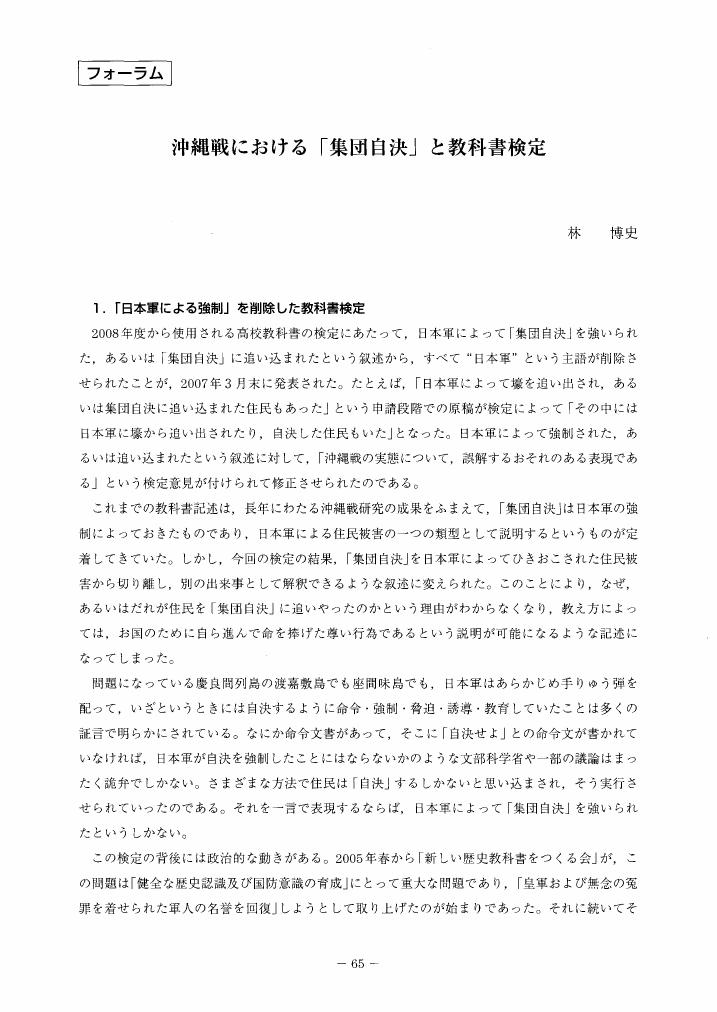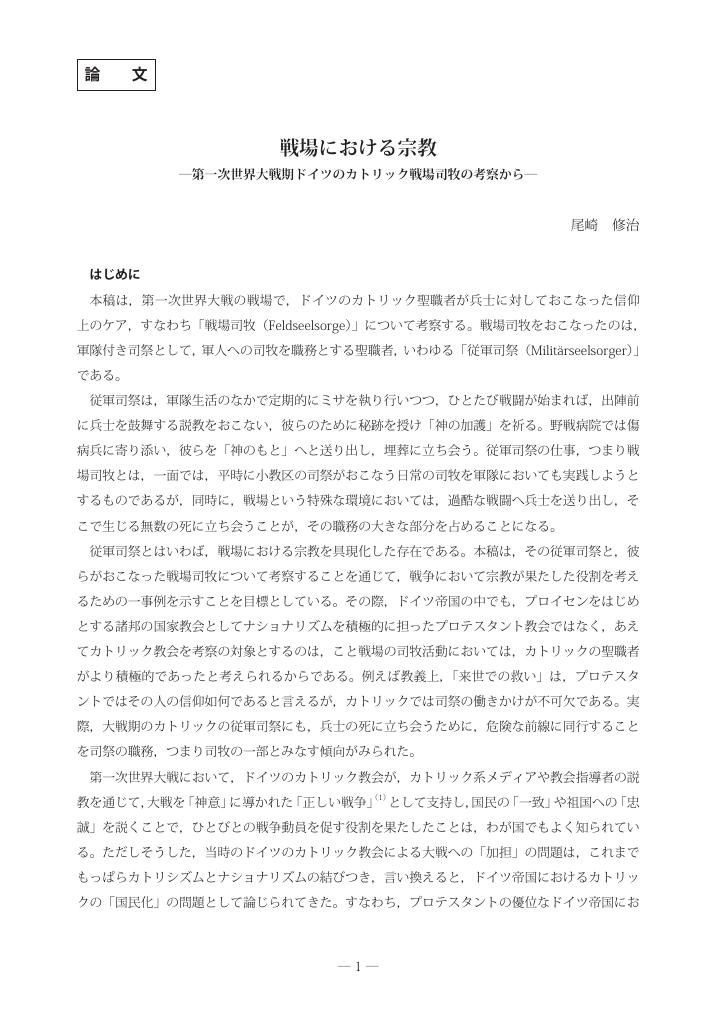21 0 0 0 OA フランスの「解放」と「帝国」 ―植民地現地人兵の戦争貢献に対する本国政府の姿勢―
- 著者
- 松沼 美穂
- 出版者
- 現代史研究会
- 雑誌
- 現代史研究 (ISSN:03868869)
- 巻号頁・発行日
- vol.50, pp.55-70, 2004-12-26 (Released:2019-08-10)
- 参考文献数
- 142
16 0 0 0 OA 戦後政治史の中の戦争責任問題
- 著者
- 吉田 裕
- 出版者
- 現代史研究会
- 雑誌
- 現代史研究 (ISSN:03868869)
- 巻号頁・発行日
- vol.40, pp.3-11, 1994-12-17 (Released:2020-11-26)
16 0 0 0 OA ヴィルヘルム期ドイツにおけるフェルキッシュ運動と宗教
- 著者
- 齋藤 正樹
- 出版者
- 現代史研究会
- 雑誌
- 現代史研究 (ISSN:03868869)
- 巻号頁・発行日
- vol.59, pp.1-17, 2013-12-20 (Released:2017-07-01)
- 参考文献数
- 77
15 0 0 0 OA 沖縄戦における「集団自決」と教科書検定
- 著者
- 林 博史
- 出版者
- 現代史研究会
- 雑誌
- 現代史研究 (ISSN:03868869)
- 巻号頁・発行日
- vol.53, pp.65-70, 2007-12-25 (Released:2018-06-28)
- 参考文献数
- 8
13 0 0 0 「東ドイツの興亡」星乃治彦--未練学派の東独論
- 著者
- 伊東 孝之
- 出版者
- 現代史研究会
- 雑誌
- 現代史研究 (ISSN:03868869)
- 巻号頁・発行日
- no.37, pp.p54-60, 1991
11 0 0 0 OA 戦場における宗教 ―第一次世界大戦期ドイツのカトリック戦場司牧の考察から―
- 著者
- 尾崎 修治
- 出版者
- 現代史研究会
- 雑誌
- 現代史研究 (ISSN:03868869)
- 巻号頁・発行日
- vol.63, pp.1-15, 2017-12-22 (Released:2020-11-26)
- 参考文献数
- 71
9 0 0 0 OA 戦時暴力を考える—第一次世界大戦初期におけるドイツ軍の残虐行為
- 著者
- ベンヤミン・ツィーマン
- 出版者
- 現代史研究会
- 雑誌
- 現代史研究 (ISSN:03868869)
- 巻号頁・発行日
- vol.66, pp.1-14, 2020-12-27 (Released:2023-09-23)
- 参考文献数
- 16
9 0 0 0 OA ホロコーストと「普通の」ポーランド人
- 著者
- 解良 澄雄
- 出版者
- 現代史研究会
- 雑誌
- 現代史研究 (ISSN:03868869)
- 巻号頁・発行日
- vol.57, pp.69-85, 2011-12-27 (Released:2017-07-01)
- 参考文献数
- 119
8 0 0 0 OA ホロコースト「現場」への考古学的アプローチ ―テクノロジーが開く新たな次元
- 著者
- 武井 彩佳
- 出版者
- 現代史研究会
- 雑誌
- 現代史研究 (ISSN:03868869)
- 巻号頁・発行日
- vol.63, pp.17-28, 2017-12-22 (Released:2020-11-26)
- 参考文献数
- 25
8 0 0 0 IR 日本降伏後における南方軍の復員過程 : 1945年~1948年
- 著者
- 増田 弘
- 出版者
- 東洋英和女学院大学現代史研究所
- 雑誌
- 現代史研究
- 巻号頁・発行日
- no.9, pp.1-159, 2013-03
- 著者
- 望月 敏弘
- 出版者
- 東洋英和女学院大学現代史研究所
- 雑誌
- 現代史研究
- 巻号頁・発行日
- no.6, pp.1-20[含 英語文要旨], 2010-03
- 著者
- 柳沢 秀一
- 出版者
- 現代史研究会
- 雑誌
- 現代史研究 (ISSN:03868869)
- 巻号頁・発行日
- vol.50, pp.21-37, 2004-12-26 (Released:2019-08-10)
- 参考文献数
- 67
- 著者
- 森村 敏己
- 出版者
- 現代史研究会
- 雑誌
- 現代史研究 (ISSN:03868869)
- 巻号頁・発行日
- vol.61, pp.49-54, 2015-12-21 (Released:2018-06-28)
- 著者
- 菊池 信彦
- 出版者
- 現代史研究会
- 雑誌
- 現代史研究 (ISSN:03868869)
- 巻号頁・発行日
- no.59, pp.55-68, 2013
6 0 0 0 OA 選挙の投票分析からみたナチズムの社会的基盤 ―いわゆる「中間層テーゼ」の再吟味―
- 著者
- 柴田 敬二
- 出版者
- 現代史研究会
- 雑誌
- 現代史研究 (ISSN:03868869)
- 巻号頁・発行日
- vol.34, pp.41-58, 1988-12-27 (Released:2020-11-26)
- 参考文献数
- 37
4 0 0 0 OA ナチズムと日本文化 ― W・ドーナートにおける日独文化提携の論理 ―
- 著者
- 清水 雅大
- 出版者
- 現代史研究会
- 雑誌
- 現代史研究 (ISSN:03868869)
- 巻号頁・発行日
- vol.61, pp.1-15, 2015-12-21 (Released:2018-06-28)
- 参考文献数
- 76
- 著者
- 長野 壮一
- 出版者
- 現代史研究会
- 雑誌
- 現代史研究 (ISSN:03868869)
- 巻号頁・発行日
- vol.61, pp.39-47, 2015-12-21 (Released:2018-06-28)
- 参考文献数
- 41
- 著者
- 高松 基之
- 出版者
- 東洋英和女学院大学現代史研究所
- 雑誌
- 現代史研究
- 巻号頁・発行日
- no.13, pp.21-78, 2017-03-31
Since 1945, 13 presidents have been sworn into office as president of the United States. Each president has adopted and developed his own unique management and decision making style. This paper aims to explore how President Dwight D. Eisenhower established his style during his presidency.In the 1950s and 1960s the prevailing image was that Eisenhower was a passive president, who reigned but did not rule, surrounded by an overly protective staff and dominated by strong cabinet secretaries such as John Foster Dulles that have been delegated too much authority. The availability of declassified materials in the Eisenhower Presidential Library challenged his passive image. At present Eisenhower is regarded as a more modern president than his youngersuccessor John F. Kennedy.Eisenhower was a president who deliberately chose to manipulate, organize, and dominate his administration with a hidden hand. Over 35 years of military experience had led Eisenhower to be deeply concerned with organizational problems. For Eisenhower, information, procedures, organization, formal meetings, and informal consultations were preparations for important decisions. Because Eisenhower placed great value on the planning process and intensive discussions, he revitalized the National Security Council (NSC) in the decision process with an appointment of Robert Cutler as the special presidential assistant on national security affairs.President Eisenhower trusted Dulles as Secretary of State and used to consult with him before and after important decisions both on foreign affairs and during the crises. There seemed to an apparent contradiction between the simultaneous existence of a strong secretary of state and a strong NSC in the White House. However, the lack of conflict between Dulles and Cutler was to due to Eisenhower’s solid confidence in secretary of state and the perception of the function of special assistant developed by Cutler. He firmly believed in the role of coordinator. Policy guidelines were formulated from the NSC process and the action of council meetings, operational decisions were usually made in the Oval Office, and diplomacy was largely in the hands of Dulles.
4 0 0 0 ロシアの文書館事情
- 著者
- 横手 慎二
- 出版者
- 現代史研究会
- 雑誌
- 現代史研究 (ISSN:03868869)
- 巻号頁・発行日
- no.47, pp.92-98, 2001
4 0 0 0 ロシアの文書館事情
- 著者
- 横手 慎二
- 出版者
- 現代史研究会
- 雑誌
- 現代史研究 (ISSN:03868869)
- 巻号頁・発行日
- vol.47, pp.92-98, 2001











